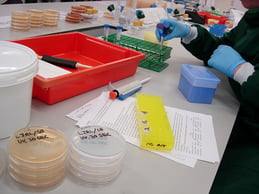
As you probably know, biotechnology has grown tremendously over the past decade. What you may not know, however, it is now being taught in some high school classes. This post will explore why biotech is being taught as early as high school and how this is paving the way for a new generation of biotech experts.
Practical Applications
The practical applications of biotechnology can be seen all around us, healing, feeding and fueling the world. The genetic makeup of agricultural crops and livestock are being altered to produce higher yields and make them more resistant to pests and diseases, while various microorganisms are being genetically modified to produce pharmaceuticals. DNA fingerprinting is being used in our courtrooms to resolve child custody issues and resolve crime, while biological molecules are now being integrated with microprocessors to create more innovative computer systems.
The Economic Impact of Biotechnology
Aside from helping ensure that proper information is given about what modern biochemistry is, and how it affects the various areas of our society, biotechnology is now being taught in high school biology classes to prepare the minds of the future generation for a career in this ever expanding field.
Since the U.S has the largest market of biotech products and services in the world, biotechnology is considered to be one of the fastest growing industries in the country. The industry now earns $450 billion in annual revenues and has a soaring demand for 2-year and 4-year college graduates, as well as entry-level workers as well.
In fact, the US biotechnology industry has created more than 198,000 high-quality jobs in various companies (pharmaceutical, agricultural, industrial, and instrumentation biotechnology companies) in the last 25 years. More people were also employed at academic and government agencies.
It is also interesting to note that the U.S. bioscience industry grew by 6.4% and added more than 1.6 million jobs between 2001 and 2010 while total employment for all private sector industries in the US fell by 2.9 % during that same period.
According to the 2014 data of the U.S. Department of Labor, employment of biotech scientists is expected to grow by 11% while the demand for biochemists and biophysicists is projected to grow by 19% from 2012 to 2022.
Moreover, while the average annual salary for other professions is pegged at $35,000, a biotechnology worker has an average annual salary of $81,000. In fact, Biomanufacturing jobs are one of the highest paying in the manufacturing sector. Entry-level workers can earn as much as $25,000 to $30,000 per year while those with considerable experience can earn as much as $40,000 to $50,000 per year.
Preparing the Youth for the Future
As with any industry that sees exponential growth, the biotechnology industry needs new workers. To address this issue, some high schools have added new curriculum (or modified existing curriculum) to teach students the fundamentals of biotechnology. These courses help to build lab proficiencies and prepare teens for a variety of post-high school options (including community or career college biotechnology programs, four-year biotechnology degree programs, and industry workplaces). In addition, biotechnology in the classrooms provides the following key benefits:
- Doing high level, relevant science
- Curious and engaged students
- Performing high-tech lab work
- Processing and sharing data
- Practicing critical thinking
- Exploring their place in the future
Features of an Excellent Biotechnology Education Program
What makes an outstanding biotechnology program? Here are some things that should be considered when choosing one:
- Comprehensive textbook with concepts and activities that support biotechnology literacy, understanding of scientific processes, bioscience vocabulary development, and biotech workplace awareness.
- Lab manual that focuses on the development of biotech laboratory skills, lab confidence, self-directedness, and appropriate workplace ethic.
- Instructor’s Guide, Course Planner, IRC, websites, and teacher workshops with continuing support for both instructors and students.
- A dynamic teacher wanting to practice real science in their classroom with their students.
Image Options: Laurence Livermore






